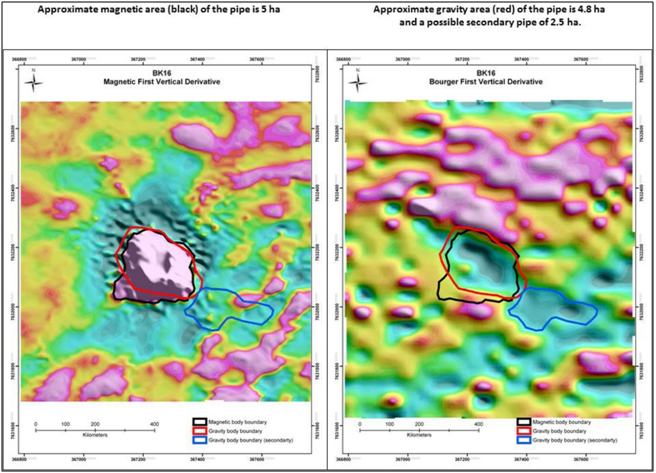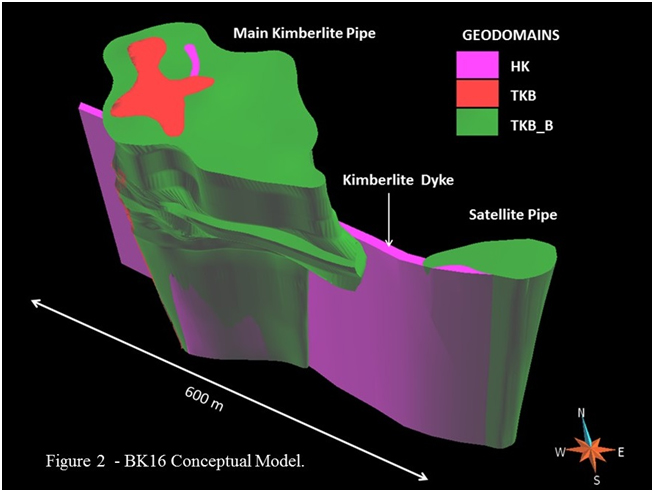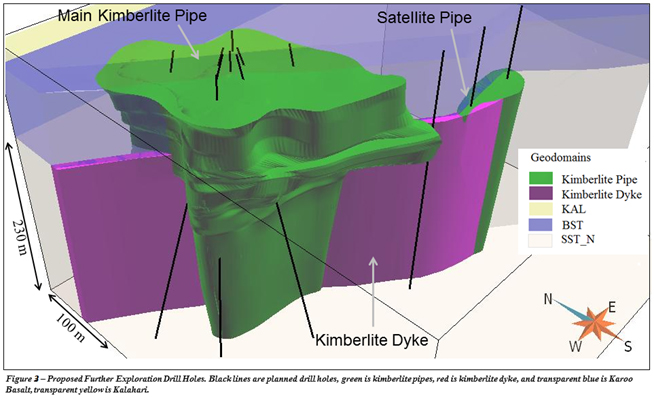Botswana Diamond Projects
BK16
INTRODUCTION
Tsodilo Resources Ltd. ("Tsodilo" or the "Company") was granted a prospecting license (PL369/2014) over the BK16 kimberlite pipe through its 100% owned Botswana subsidiary, Bosoto Pty (Ltd), in October 2014. The BK16 kimberlite pipe is located within the Orapa Kimberlite cluster in Botswana and is 37 kilometers ("km") east-southeast of the Orapa Diamond Mine AK01, 25 km southeast of the Damshtaa Diamond Mine, and 13 km north-northeast of the Letlhakane Diamond Mine, all operated by Debswana and 28 km East-northeast from Lucara Diamond Corporation's Karowe mine (F/K/A AK6).
BK16 is one of the known diamondiferous kimberlites of the Orapa Kimberlite Field ("OKF") in Botswana and will be evaluated for its economic potential by Bosoto. The OKF lies on the northern edge of the Central Kalahari Karoo Basin along which the Karoo Supergroup dips very gently to the SSW and off-laps against an irregular pre-Karoo topography of Precambrian rocks which outcrops within the Makgadikgadi Depression.
The OKF includes at least 83 kimberlite bodies, varying in size from insignificant dykes to the 110 hectare AK01 kimberlite pipe. The AK01 pipe has been dated at 93.1 Ma and it is presumed that all the kimberlite intrusions in the OKF are of similar and post-Karoo age. Of the 83 known kimberlite bodies, nine (9), AK01 (Orapa, Debswana); AK06 (Karowe, Lucara Diamond Corporation); BK01, BK09, BK12 and BK15 (Damtshaa, Debswana); DK01 and DK02 (Letlhakane, Debswana); BK11 (Firestone Diamonds), are currently being or have been mined.
EXPLORATION HISTORY
The BK16 kimberlite was initially discovered by De Beers in the 1970's using soil sampling techniques, airborne magnetics, and ground magnetic surveys. This initial work was followed up by some initial drilling and the sinking of a shallow shaft to 36 meters in the central part of the pipe. Initial indications were that the kimberlite was diamondiferous albeit low grade and no further work was done by De Beers.
Over the period 1994 to 2010, several companies held the prospecting rights over the area containing the BK16 kimberlite and various forms of surveying and sampling were employed all in an attempt to ascertain whether BK16 was economically viable. However, none of those efforts systematically evaluated the kimberlite to answer the question as to BK16's merits. Tsodilo believes that much of the above described sampling was done in the upper part of the kimberlite which is characterized by a basalt breccia. Like several of the other Orapa kimberlites, this upper zone of basalt diluted kimberlite is of low grade but the underlying 'cleaner' kimberlite, as is the case at BK16, is known to be of higher grade.
GEOPHYSICAL SURVEYS
The first work Bosoto undertook on BK16 was to complete 51 line kilometers of high resolution (closely spaced) ground magnetic survey and 441 survey stations of detailed gravity survey over the license. These two surveys are more detailed than any previous geophysical survey over the BK16 kimberlite, this detail was needed to more accurately estimate the size of the pipe. The magnetic data was surveyed on lines 20 meters apart and readings were taken every 5 seconds. The Gravity survey meter for the gravity survey took readings every 50 meters on lines 50 meters apart, these gravity stations were measured for elevation using a differential GPS. All data was processed and modelled using in-house Geosoft and PotentQ software.
The magnetic and gravity data had excellent overlaps showing the extent of the kimberlite pipe to be between 4.8 and 5 hectares in size with a high level of confidence due to the high precision nature of our surveys. These geophysical surveys also highlighted different zones within the kimberlite, which are most likely associated with different kimberlite facies.
Figure 1 shows the ground magnetic data and the gravity data. The gravity data suggests there is a possible extension of the main kimberlite pipe towards the southeast which is around 2.5 hectares in size. The magnetic results over this area are not conclusive and this area will have to be tested by drilling.
 Figure 1. Left is the magnetic first vertical derivative ground magnetic data and the right is the Bouger gravity first vertical derivative data for the BK16 license area.
Figure 1. Left is the magnetic first vertical derivative ground magnetic data and the right is the Bouger gravity first vertical derivative data for the BK16 license area.
BK16 CONCEPTUAL GEOLOGICAL MODEL
Bosoto reviewed all of the available historical drill data including geological logs to create a conceptual geological model for BK16, see Figure 2. Also incorporated into this conceptual model was the Company's high resolution ground magnetic and gravity survey results.

The historical drill data used for this project includes 27 boreholes to a cumulative depth of 3,553.25 meters. Which were a combination of 12-inch reverse circulation drilling (5 holes, 641 meters), 6.5-inch percussion holes (19 holes, 2,290 meters), and HQ diamond drilling (3 holes, 622.25 meters).
Along with the main kimberlite pipe the geophysical model supports the presence of a smaller satellite pipe to the south-east of the main pipe where kimberlite has been intersected by two of the historical exploration drill holes. The main pipe and this second pipe have been interpreted to be linked by a north-west trending dyke based on the geophysics. This second intrusion has not penetrated the Karoo basalts and if therefor interpreted as a blind pipe, see Figure 3.

NEXT PHASE - EVALUATION DRILLING
The conceptual model above has been used as a platform to design the upcoming drill program. There have been 12 diamond drill core holes planned to a cumulative depth of 4,200 meters, these will be drilled using Tsodilo's drill rigs. The planned drill holes are shown on Figure 3. This drill plan will enable the company to establish a more robust geological model that will be used to site the planned 38 Large Diameter Drill (LDD - 24-inch) holes for bulk samplings to obtain the sample grades of the various kimberlite facies and variation thereof across the pipe. Once this has been established the next phase will be to site the next phase of drilling to extract sufficient diamond for valuation purposes.
If you can't view the image below, please download the PDF file
here. (Right Click the link and Save Link As..)




